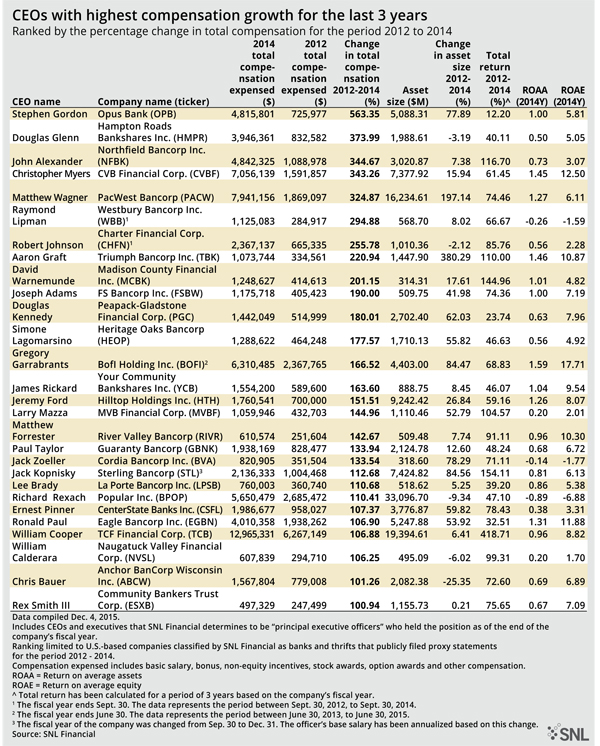M&A and better economy buoy CEO comp
SNL Report: With improving economy, CEO pay rebounds from "last bad year" of 2012
- |
- Written by SNL Financial
 SNL Financial is the premier provider of breaking news, financial data, and expert analysis on business sectors critical to the global economy. This article originally appeared on the subscriber side of SNL Financial's website.
SNL Financial is the premier provider of breaking news, financial data, and expert analysis on business sectors critical to the global economy. This article originally appeared on the subscriber side of SNL Financial's website.
By Rabia Arif and Agha Sibtain Ali, SNL Financial staff writers
An improved financial climate and an uptick in M&A activity were the biggest factors that boosted CEO compensation from 2012 to 2014 in the U.S. banking industry.
Who got the greater green
In order to see where in the sector CEO compensation grew the fastest, SNL looked at banks' CEOs and principal executive executives, who consistently held the top job at their institution's fiscal year-end from 2012 to 2014. The analysis covers U.S.-based companies classified by SNL as banks and thrifts that publicly filed proxy statements during the time frame, and compares CEO compensation levels in 2014 with 2012.
In 2014, Stephen Gordon, chairman, president, and CEO of Irvine, Calif.-based Opus Bank; Douglas Glenn, president and CEO of Hampton Roads Bankshares Inc.; Matthew Wagner, president and CEO of Los Angeles-based PacWest Bancorp; Montebello, N.Y.-based Sterling Bancorp's President and CEO Jack Kopnisky; Dallas-based Triumph Bancorp Inc.'s Vice-Chairman, President, and CEO Aaron Graft; and San Diego-based BofI Holding Inc.'s President and CEO Gregory Garrabrants, were among the head honchos who earned the biggest raise in their total compensation compared to 2012.
In terms of institutional size, chief executives leading banks with $1 billion to $10 billion in assets got the highest number of 100%-plus jumps in their total pay for 2014 compared to 2012. CEOs of banks with $100 billion to $500 billion in assets saw the largest increase in total compensation levels.
How leaders did by bank size range
Year over year, total compensation for CEOs at banks with assets between $1 billion and $5 billion grew at a median of 14.65% in 2014, compared to 13.62% in 2012.
Banks ranging from $5 billion to $10 billion in asset size saw median year-on-year growth of 19.50% in total CEO compensation in 2014, compared to 7.67% in 2012.
Banks in the range of $10 billion to $100 billion asset size saw a year-over-year median growth of 9.88% in total CEO compensation in 2014, compared to 11.65% in 2012.
CEOs at banks with $100 billion to $500 billion in assets saw their total compensation jump at a median of 35.64% in 2014, compared to 21.09% in 2012.
Banks with more than $500 billion in assets saw their total compensation climb at a median of 13.84% in 2014, from 9.08% in 2012.
Looking at compensation trends
Laura Hay, managing director at compensation consulting firm Pearl Meyer, said that 2012 was perhaps "the last bad year" for executive compensation in the banking world.
Because of mandates or performance, banks had most probably suspended performance-based award programs during the year, she told SNL.
But as banks started returning to profitability with the recovering economy, compensation started to show targeted or increased payouts in their performance-based programs—which, once reinstated, even more than doubled the bottom line for some occupants of the corner office. Hay described 2012 as something of a turning point for compensation in the sector.
Todd Leone, a partner at McLagan, an Aon Hewitt company that consults financial institutions on performance, noted that smaller banks recovered more gradually from the recession. Leone said that banks with $10 billion to $25 billion in assets dropped "hard and fast" in 2009, but recovered quickly.
Performance-based awards
SNL data shows a slight increase in the number of banks that granted stock and option awards from 2012 to 2014, while total equity-based compensation grew approximately 21% over the time period.
Of the 582 banks in 2012, a total of 304 banks granted equity-based compensation to CEOs, including 115 banks with assets between $1 billion to $5 billion. In comparison, a total of 333 banks out of 570 banks in 2014, including 126 banks with $1 billion to $5 billion in assets, awarded performance-based compensation to its CEOs.
Hay commented that base salaries showed moderate growth over the time period, so if banks compensated their CEOs at higher levels in 2014, it was mainly through short- and long-term compensation.
PacWest's Wagner received approximately $5.7 million in stock awards and saw a raise of almost 65% in his non-equity based incentive plan compensation in 2014, whereas the executive did not receive any equity-based compensation in 2012.
Similarly, Opus Bank awarded Gordon approximately $3.5 million in stocks and options in 2014, contributing to an increase of approximately 563% in his overall compensation, while he did not receive any equity-based compensation in 2012.
BofI's Garrabrants saw an increase of 166.52% in his total compensation as the company increased its total assets by 84.47% from 2012 to 2014. The increase in the executive's compensation was mainly because of approximately $4.2 million in stock awards in 2014, up from $660,380 in 2012
Asset size does matter
Compensation levels increase as the banks' asset size goes up. The median total compensation expense during 2014; for CEOs of banks with $10 billion to $100 billion in assets, was almost $4 million; for banks with $100 billion to $500 billion in assets, the median total CEO compensation amounted to approximately $12.5 million; whereas the median total compensation for CEOs of the four largest U.S. banks was approximately $18 million. Larger organizations entail a larger scope of responsibility that is matched with higher level of compensation, Leone told SNL.
He also noted that almost all banks with assets between $1 billion to $10 billion saw increases in compensation levels from 2013 to 2014, compared to any other asset class. He also noted that total compensation for CEOs of banks with less than $500 million in assets decreased since 2012, which Leone related to regulatory pressure; while total compensation levels for CEOs of banks with more than $10 billion in assets decreased in 2013 and went back up in 2014.
While commenting on the relationship of banks' asset sizes with compensation, Hay told SNL that they are “positively correlated." She also noted that banks that grow through M&A can see fairly significant changes in executive's compensation.
Opus Bank's Gordon saw the most gain—of approximately 563%—in his compensation from 2012 to 2014, as the company grew its total assets by 78% over the period with the acquisition of four branches from Salt Lake City-based Zions Bancorp. on Aug. 16, 2013, and 10 branches from PacWest on Sept. 21, 2012. According to the company's performance criteria, the covered executives' performance is based on return on average assets, return on average equity, return on average tangible equity, general and administrative expenses over average assets, and/or regulatory rating, among other factors.
Elsewhere, PacWest increased its total assets by approximately 197% from 2012 to 2014, by completing multiple successful deals, including the acquisition of Los Angeles-based CapitalSource Inc. for approximately $2.4 billion, while trimming its branch network through the sale of 10 branches to Opus. The company also recently closed its acquisition of Durham, N.C.-based Square 1 Financial Inc. in October. Wagner, president and CEO of PacWest, saw an increase of approximately 325% in his total compensation from 2012 to 2014. Based on the company's performance criteria, the company exceeded its targeted core deposits by $244.6 billion, and met its targeted loans and leases amount of $11.91 billion in 2014.
In addition, at Sterling, Kopnisky's total compensation grew 112.68% from 2012 to 2014, as the company generated a total return of 154.11% and grew its assets by 84.56% over the same time frame. Formerly known as Provident New York Bancorp, the company completed three successful bank deals from 2012 to 2014, including a merger with Sterling Bancorp in 2013 and the acquisition of Hudson Valley Holding Corp. in June, which was announced in November 2014. Kopnisky received $900,010 in stock awards along with $500,000 in non-equity-based incentive plan compensation in 2014. In 2012, the executive received $412,500 in non-equity-based incentive plan compensation.
Regulatory factors
Regulatory factors also played a vital part in affecting the CEOs' compensation from 2012 to 2014, along with economic conditions, M&A activity and performance-based awards. Interest rates directly affected defined benefit plans. The interest rate environment did not only impact the bank's profit and loss accounts, but also the CEO compensation, Leone told SNL.
Dodd-Frank Act, five years of say-on-pay and the upcoming SEC proposals concerning clawback rules, and pay-for-performance are important contributing factors toward CEO compensation, Leone told SNL.
Pursuant to the say-on-pay rule, shareholders are required to vote on executive compensation at least once every three years. In addition, the rules require companies to hold a frequency vote at least once every six years to allow shareholders to decide how often they would like to be presented with the say-on-pay vote, which needs to be disclosed in an SEC filing.
Under the clawback rule, the SEC proposed that erroneously awarded incentive-based compensation would be recovered from current and former executives at listed companies. The rule further explains that the recovered amount in a clawback will be equal to the amount received in excess of what should have been paid after the accounting restatement of a company's financials.
Along the same lines, under the pay-for-performance proposal, reporting companies would have to disclose total shareholder returns on an annual basis going back five years, as well as five years of total shareholder returns for their peer group. The proposal would also require companies to disclose executive compensation "actually paid" to the principal executive officer and the average actually paid to other named executive officers.
Increased regulatory activity will play a vital role in determining the future compensation levels for banks' CEOs. "The regulatory aspects of Dodd-Frank will be going online relatively soon. It's something that everybody needs to ensure that they are looking out for," said Leone.
This article originally appeared on SNL Financial’s website under the title, “With improving economy, CEO pay rebounds from 'last bad year' of 2012.”
Tagged under Human Resources, Management,
Related items
- JP Morgan Drops Almost 5% After Disappointing Wall Street
- Banks Compromise NetZero Goals with Livestock Financing
- OakNorth’s Pre-Tax Profits Increase by 23% While Expanding Its Offering to The US
- NYCB Receives $1 Billion Lifeline
- Capital One’s $35 Billion Bid to Aquire Discover Financial and What It Means















